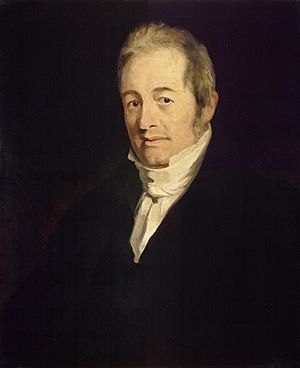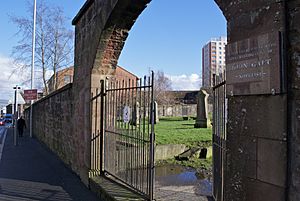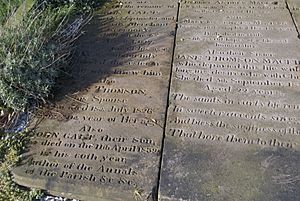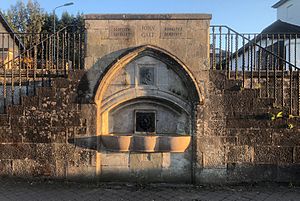John Galt (novelist) facts for kids
Quick facts for kids
John Galt
|
|
|---|---|
 |
|
| Born | 2 May 1779 Irvine, Ayrshire, Scotland |
| Died | 11 April 1839 (aged 59) Greenock, Scotland |
| Occupation | Writer, colonial businessman |
| Nationality | British |
| Period | 1812–1839 |
| Genre | poetry, drama, short stories, travel writing |
| Notable works | Annals of the Parish The Chronicle of Dalmailing |
| Spouse | Elizabeth Tilloch |
| Signature | |
 |
|
John Galt (/ɡɔːlt/; May 2, 1779 – April 11, 1839) was a Scottish writer, businessman, and social thinker. He is known for his novels, plays, and travel writings. Some people call Galt the first "political novelist" in the English language. This is because he was the first writer to explore issues related to the Industrial Revolution in his stories.
Galt was also important in the early settlement of Canada. He was the first leader of the Canada Company from 1826 to 1829. This company helped people move to and settle in what is now Southern Ontario (then called Upper Canada). This effort is seen as a very important part of Canadian history.
In 1829, Galt returned to Great Britain. He faced challenges with how he managed the Canada Company. Later, he had financial difficulties. His book, Autobiography, published in 1833, talks about his life and work in Canada.
He was the father of Sir Alexander Tilloch Galt from Montreal, Quebec. Alexander later became a key figure in Canada's history.
Contents
Life Story of John Galt
Early Years and Education
John Galt was born in Irvine, Scotland, in 1779. His father was a naval captain involved in trade with the West Indies. When John was one year old, his family moved to Greenock. He went to Irvine Grammar School.
At 17, Galt worked for the Greenock Custom House for a short time. He then became a clerk for his uncle. In his free time, he wrote essays and stories for local newspapers. In 1804, he moved to London to find new opportunities. He later began studying law in 1809.
Travels and Early Writing
Galt traveled to Europe to set up trade agreements for a business. During this trip, he met and became friends with the famous poet Lord Byron in Gibraltar. They traveled together to Malta and met again in Greece. Galt then continued his journey alone to Constantinople and other cities before returning home.
After his travels, Galt focused on writing. He published a book about his journeys, which was quite successful. Years later, he also wrote the first full biography of Lord Byron. He also wrote a biography of the painter Benjamin West.
In 1813, Galt tried to start a trading company in Gibraltar. This was to get around Napoleon's trade rules against Britain. But when Wellington won battles in Spain, this company was no longer needed. Galt returned to London and married Elizabeth Tilloch. They had three sons. In 1815, he became Secretary of the Royal Caledonian Asylum in London.
Becoming a Famous Writer
Galt began writing for Blackwood's Magazine in 1819. In 1821, his novel Annals of the Parish was published. This book quickly made him famous. He also wrote other novels like Sir Andrew Wylie and The Steam-Boat. He often moved his family, living in London, Glasgow, Edinburgh, and other places. He also wrote school books under the name Reverend T. Clark.
Work with the Canada Company
In 1824, Galt became the secretary of the Canada Company. This company was created to help settle the Huron Tract in Upper Canada. The Huron Tract was a large area of land (about 1.1 million acres) near Lake Huron. The company surveyed this land, built roads, mills, and schools. They also helped new settlers move to the area.
After the company officially started in 1826, Galt traveled to Canada. He lived in York (now Toronto, Ontario). He chose Guelph, Ontario as the company's main office and helped found the town in 1827. Later that year, he also helped found the town of Goderich with Tiger Dunlop. The town of Galt, Ontario, was named after him.
During his time in Canada, Galt faced disagreements with some colonial leaders. His employers also criticized him for his accounting skills and not following their plans. This led to him being asked to return to Great Britain in 1829.
Later Life and Health Challenges
After returning to Great Britain, Galt faced financial difficulties. One of his last novels, The Member, was about political problems.
In 1831, he moved to Old Brompton. Despite his health getting worse after an injury in Canada, Galt joined another business venture. This was the British American Land Company, which aimed to develop lands in Lower Canada (now Quebec). Galt worked as secretary but had to leave in 1832 because of his health. His spinal injury made it hard for him to move, speak, and write.

In 1834, Galt moved to Edinburgh after his two-volume Autobiography was published in 1833. He met travel writer Harriet Pigott there. Galt helped Pigott edit her book, Records of Real Life in the Palace and the Cottage.
He returned to his old home in Greenock in August 1834. This was after three of his sons moved to Canada. John Galt died on April 11, 1839. He was buried in his family's tomb in the New Burying Ground in Greenock.
John Galt's Legacy
John Galt is remembered in several ways. In Greenock, Scotland, there is a memorial fountain and a plaque at the cemetery where he is buried. A building for seniors, built in 1988, is named John Galt House in his honor.
He is also honored in Makars' Court in Edinburgh. In 2006, the town of Guelph, Canada, started celebrating "John Galt Day" on the first Monday in August.
The city of Galt, Ontario, was named after him. However, it later became part of Cambridge, Ontario in 1973. His first home in Guelph, called the "Priory," was built in 1827-1828. It was later torn down in 1926.
A historical plaque in Canada remembers Galt's important role with the Canada Company. It calls their settlement efforts "the most important single attempt at settlement in Canadian history."
John Galt's Works
Galt's novels are best known for showing Scottish country life with a touch of funny irony. Here are some of his works:
- Cursory Reflections on Political and Commercial Topics (1812)
- The Life and Administration of Cardinal Wolsey (1812)
- The Tragedies of Maddelen, Agamemnon, Lady Macbeth, Antonia and Clytemnestra (1812)
- Voyages and Travels (1812)
- Letters from the Levant (1813)
- The Mermaid (1814)
- The Life and Studies of Benjamin West (1816)
- The Majolo (2 volumes) (1816)
- The Appeal (1818)
- The Star of Destiny (a three act play, 1818)
- The History of Gog and Magog: The Champions of London (children's book, 1819)
- The Wandering Jew (1820)
- The Earthquake (3 volumes) (1820)
- Glenfell (1820)
- The Life, Studies and Works of Benjamin West (1820)
- Annals of the Parish (1821)
- The Ayrshire Legatees (1821)
- Sir Andrew Wylie, of that Ilk (3 volumes) (1822)
- The Provost (1822)
- The Steam-Boat (1822)
- The Entail (3 volumes) (1823)
- The Gathering of the West (1823)
- Ringan Gilhaize (The Covenanters) (3 volumes) (1823)
- The Spaewife (3 volumes) (1823)
- The Bachelor's Wife (1824)
- Rothelan (3 volumes) (1824)
- The Omen (1825)
- The Last of the Lairds (1826)
- Lawrie Todd or The Settlers in the Woods (1830)
- The Life of Lord Byron (1830)
- Southennan (3 volumes) (1830)
- The Book of Life (1831)
- The Black Ferry (variant of The Book of Life)
- Bogle Corbet or The Emigrants (3 volumes) (1831)
- The Lives of the Players (1831)
- The Member: An Autobiography (1832) – novel
- The Radical (1832) – novel, sequel to The Member
- Stanley Buxton (3 volumes) (1832)
- Autobiography (2 volumes) (1833)
- Eben Erskine or The Traveller (3 volumes) (1833)
- The Ouranoulagos or The Celestial Volume (1833)
- Poems (1833)
- The Stolen Child (1833)
- Stories of the Study (3 volumes) (1833)
- Literary Life and Miscellanies (3 volumes) (1834)
- A Contribution to the Greenock Calamity Fund (1834)
- Efforts by an Invalid (1835)
- The Demon of Destiny and Other Poems (1839)




